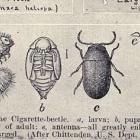Historical accounts document the beginning of white settler tobacco farming in the colony of Southern Rhodesia (now Zimbabwe) around 1893. Despite the new and unfamiliar production environment, the occurrence of pests and diseases appear to have been rare and intermittent during these early days. The first record of pesticide use occurred in 1906 when the Government tobacco expert recommended the use of Paris Green for the control of grasshoppers. Paris Green and Arsenic were also used for the control of cutworms and wireworms which are mentioned in entomological reports as having been a concern in most tobacco farms. The first tobacco diseases in Rhodesia were Tobacco mosaic virus, Frogeye, and White mould. Frogeye was first reported from North Carolina in 1893 and was prevalent in other tobacco growing areas of the world. There was no known chemical control for these early diseases except pruning off the affected leaves. The other diseases, Wildfire and Angular leaf spot, were first described in 1921 by the colony’s Department of Agriculture plant pathologist as having been introduced by tobacco seed imported from the USA. The Bordeaux mix was highly recommended as a fungicide, but the most effective method for control was hygienic cultural practices in seedbeds and cultivation.
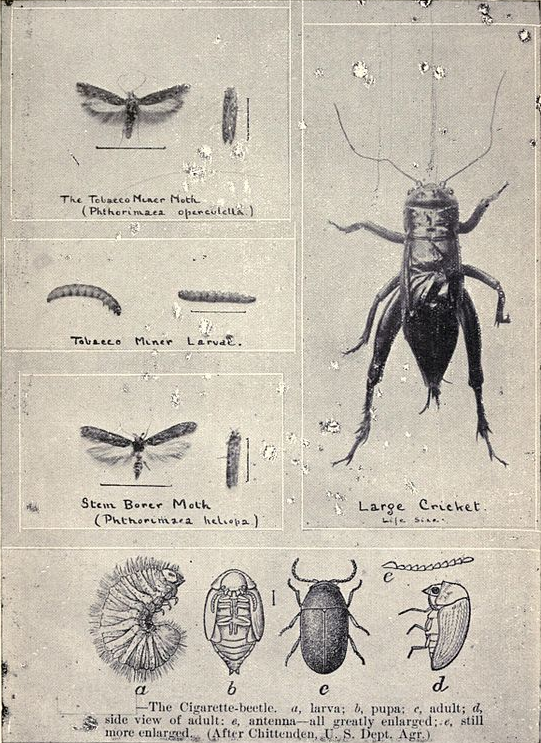
Insect pests of Tobacco in Southern Rhodesia.
Insect pests of Tobacco in Southern Rhodesia.
Unknown illustrator, n.d.
Accessed via Wikimedia on 5 June 2019. Click here to view source.
 This work is licensed under a Creative Commons Public Domain Mark 1.0 License.
This work is licensed under a Creative Commons Public Domain Mark 1.0 License.
However, the incidences of tobacco diseases increased significantly from 1927 as a result of acreage expansions. In the years 1926–1928, tobacco acreages increased from 16 249 to 46 622 acres causing a crisis of overproduction. This expansion of tobacco acreages created extensive incubators for pests and diseases as tobacco became largely single-cropped and the practice of rotations receded. As a result, beginning in 1927, field experiments on the control of pests and diseases were being conducted by the state at the Hillside tobacco experimental station in the use of fungicides for the control of widespread bacteriological diseases. For stored cured tobacco, the notorious pests were Ephestilla elutella (tobacco warehouse moth) and the cigarette beetle. These two caused much damage and contaminated stored tobacco in warehouses ready for export such that the government had to enact a Pest Control and Suppression Act in 1931 to regain the confidence of overseas buyers and raise the market value of tobacco through mandatory registration and inspection of all tobacco warehouses.
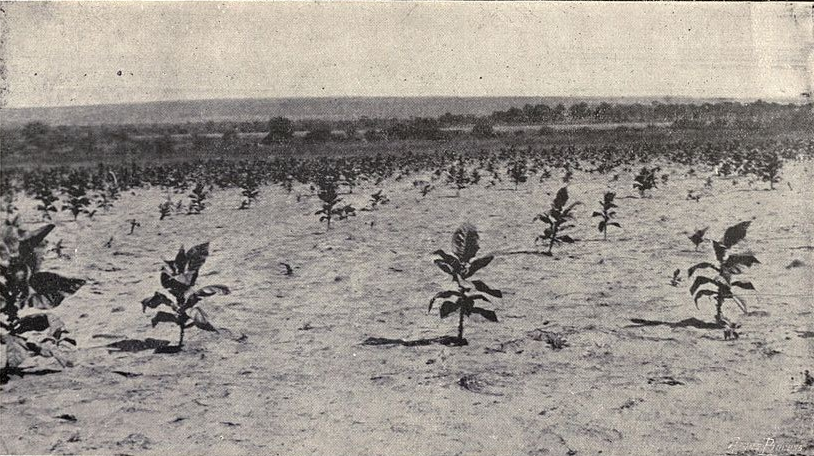
Field of Tobacco in Southern Rhodesia injured by Stem Borer.
Field of Tobacco in Southern Rhodesia injured by Stem Borer.
Unknown photographer, n.d.
Accessed via Wikimedia on 5 June 2019. Click here to view source.
 This work is licensed under a Creative Commons Public Domain Mark 1.0 License.
This work is licensed under a Creative Commons Public Domain Mark 1.0 License.
In 1933, there was an outbreak of the first insect-borne tobacco disease in Southern Rhodesia—Leaf curl. The Government responded with an amendment to the Tobacco Pest Control and Suppression Act, which made it mandatory for tobacco farmers to destroy all stalks by 1 August of each year. From 1937–44 there was a huge outbreak of Tobacco Alternaria in most tobacco producing areas of Southern Rhodesia which caused heavy losses. By March 1940 the government estimated that the disease had caused losses amounting to 3.5 million lbs of tobacco. Consequently, field-spraying experiments were conducted by the state on a larger scale and the number of fungicides and pesticides used annually for seedbed spraying steadily increased as most farmers adopted spraying both in the seedbed and lands.
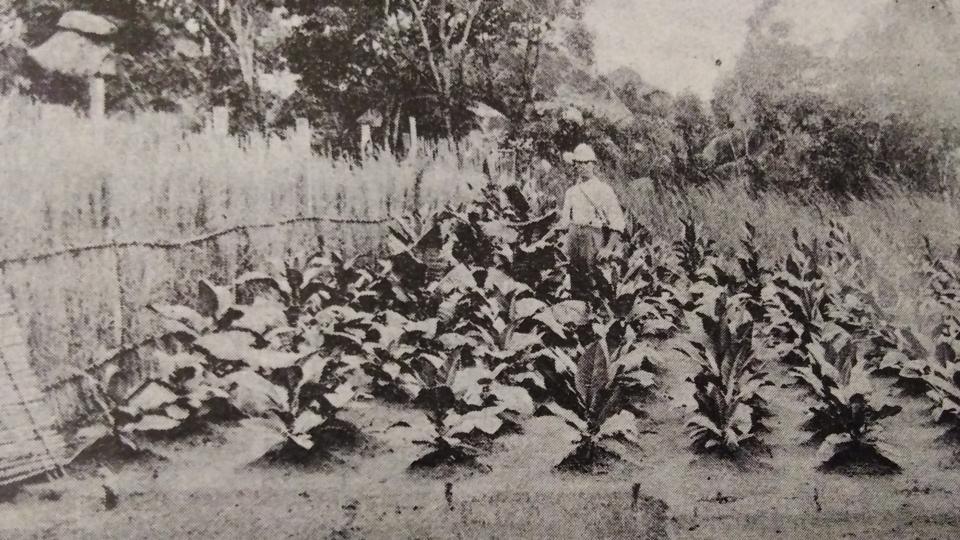
A tobacco crop belonging to one of the Rhodesian pioneer growers, Mr. E. H. South, 1910.
A tobacco crop belonging to one of the Rhodesian pioneer growers, Mr. E. H. South, 1910.
Unknown photographer, 1910.
Courtesy of the National Archives of Zimbabwe.
 This work is licensed under a Creative Commons Public Domain Mark 1.0 License.
This work is licensed under a Creative Commons Public Domain Mark 1.0 License.
These field sprays, however, largely relied on arsenic-based compounds such as copper arsenate and lead arsenate (a poison then used as dip for tick control amongst livestock). Rachel Carson’s Silent Spring and other later studies revealed that arsenic contaminates the environment, poisons the soil, and causes sickness and death to livestock. Peter Uledi and Godfrey Hove, in their most recent study of locust outbreaks and state response in Southern Rhodesia between 1918–1951, pointed out the environmental impacts of the use of arsenate of soda during the 1932 and 1938 anti-locust campaigns. These included serious problems of human poisoning and deaths, the destruction of birds, and livestock losses contained in various reports of the Veterinary and Chemistry branches of Southern Rhodesia between 1932 and 1943.
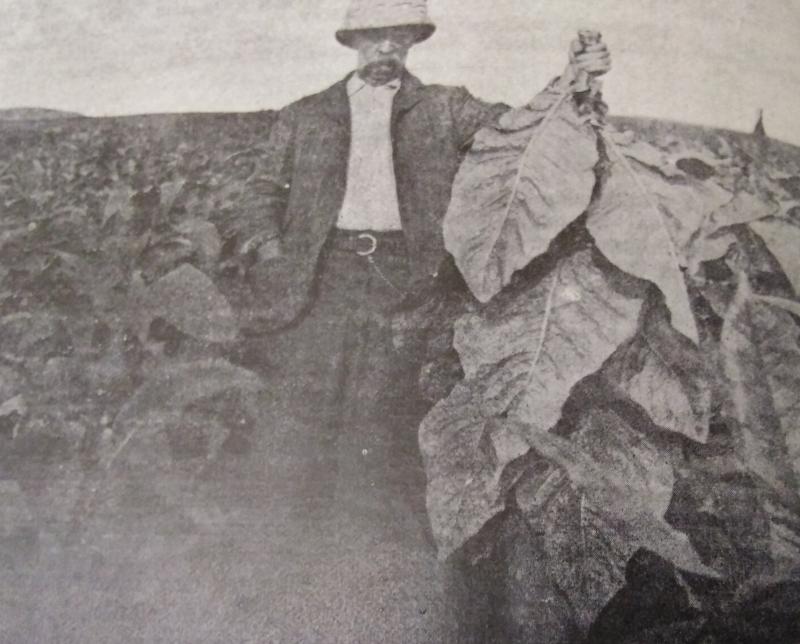
Manager of the Rhodesia Tobacco Syndicate Dr. Charles Jarron Sketchely holding harvested tobacco, 1910.
Manager of the Rhodesia Tobacco Syndicate Dr. Charles Jarron Sketchely holding harvested tobacco, 1910.
Unknown photographer, 1910.
Courtesy of the National Archives of Zimbabwe.
 This work is licensed under a Creative Commons Public Domain Mark 1.0 License.
This work is licensed under a Creative Commons Public Domain Mark 1.0 License.
Although the magnitude and scale of use in quantitative terms in tobacco farms of these poisons pale in comparisons to the quantities used during the anti-locust campaign, the residual cumulative impact of these chemicals in tobacco fields over long periods cannot be ignored. In the United States, although arsenic chemical sprays in tobacco had been replaced by the synthetic chlorinated hydrocarbons from the mid-1940s, tobacco plants continued to take arsenic poison from the heavily contaminated soils and the arsenic content of cigarettes increased by more than 300% between 1932 and 1952. Although there have not been any empirical quantitative studies carried out in Southern Rhodesia to evaluate the net effects of arsenic-based compounds in tobacco field sprays to the environment, it is apparent that lands, pastures, and water bodies were polluted since the use of these poisons was largely unregulated by then. There was also a marked increase in cattle poisonings from Nitrate of Soda—a tobacco fertilizer which was described as quite a common occurrence in January 1942 by the Veterinary Department of Southern Rhodesia. In 1941, E.P Hodgson, a state cattle inspector, wrote that arsenic poisoning was largely due to careless use of the poison on the farms as a locust poison and as an insecticide.
The use of chemical pesticides for the control of tobacco pests and diseases in Southern Rhodesia had a negative impact on the human and natural environment. Although it is difficult to ascertain the exact magnitude of the damage it is apparent that there were many incidences of contamination and poisoning.
How to cite
Doro, Elijah. “An Environmental History of Tobacco Pests and Diseases in Southern Rhodesia, 1893–1940.” Environment & Society Portal, Arcadia (Summer 2019), no. 31. Rachel Carson Center for Environment and Society. doi.org/10.5282/rcc/8766
ISSN 2199-3408
Environment & Society Portal, Arcadia
 This work is licensed under a Creative Commons Attribution 4.0 International License.
This work is licensed under a Creative Commons Attribution 4.0 International License.
2019 Elijah Doro
This refers only to the text and does not include any image rights.
Please click on an image to view its individual rights status.
- Carson, Rachel. Silent Spring. London: Hamish Hamilton, 1963.
- Clements, Frank, and Edward Harbern. Leaf of Gold: The Story of Rhodesian Tobacco. London: Methuen and Co. Ltd, 1962.
- Jack, Rupert W. Insect Pests of Tobacco in Southern Rhodesia. Salisbury, The Department of Agriculture, n.d.
- Rubert, Steven C. A Most Promising Weed: A History of Tobacco Farming and Labor in Colonial Zimbabwe, 1890–1945. Athens: Ohio University Center for International Studies, 1998.
- Satterlee, Henry S. “The Problems of Arsenic in American Cigarette Tobacco.” New England Journal of Medicine 254 (1956): 1149-54.
- Scott, Peter. “The Tobacco Industry of Southern Rhodesia.” Economic Geography 28, no.3 (1952): 189–206.



